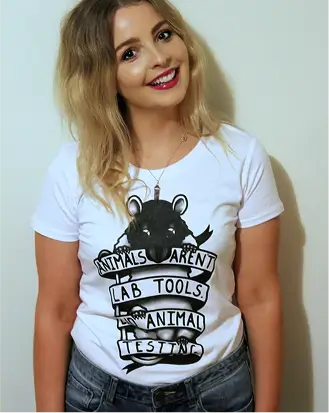Some institutes are already using non-harmful or animal-free research, testing and teaching methods. Here are just a few examples...
TEACHING
TRAINING VET STUDENTS AT MASSEY UNIVERSITY
Massey University in Palmerston North has a Veterinary Skills Laboratory which is essentially a room full of alternative methods to using live animals for training vet students. These methods are used by students to improve their clinical skills. Students can use bananas, oranges, teddy bears and fake skin to practice surgical skills on.
More sophisticated methods in their lab include interactive models such as:
- Cow mannequins that can simulate pregnant cows, right down to the temperature and feel (i.e. the mannequin has special areas that warm water can be added so that the inside of the model feels realistic).
- Canine models that have artificial heartbeats. These have different sound modules to replicate different heart conditions.
- A life-sized mannequin of a horse that has a removable back and realistic intestines that can be manipulated to model the different types of intestinal abnormalities horses unfortunately get. Students can then diagnose the ailment using the traditional technique, feeling for the abnormality via the horse’s rectum.
While the use of these non-harmful tools isn't formally part of the curriculum yet, the Veterinary Skills Laboratory is open for students to come and practise in 24/7.

TRAINING VET NURSES AT OTAGO POLYTECHNIC
Otago Polytechnic doesn’t use any live animals, in ways that we would consider harmful, to teach students and they don’t keep any live animals on their campus.
Otago Polytechnic uses a lot of different models and simulation manikins, some handmade and others purchased. They make their own mock iv simulators and their own fake blood, and instead of using ethically sourced canine cadavers, they now use canine dental models.

OPTING OUT AT CANTERBURY UNIVERSITY
Ruby Reedy-Land, a student studying at Canterbury University, successfully opted out of an assignment that would have involved killing insects and pinning their bodies to a board. After defending her rights as a student, she was given an alternative assignment where instead of killing insects, she took photos of them.

TESTING
TESTING SHELLFISH FOR TOXINS AT CAWTHRON INSTITUTE
Instead of using mice in cruel and unreliable experiments to test shellfish for toxins, the Cawthron Institute developed a chemical method of testing.
This method involves using certified reference standards for the actual chemicals that cause the toxicity to quantify the amount of these chemicals in shellfish. In other words, they measure the level of the toxic compound rather than the effect of that compound on a mouse.
The use of this more reliable non-animal-based replacement method means that thousands of mice are saved from pointless tests each year. No mice have been used by the Cawthron Institute for testing of the toxin since 2010.
One of our core beliefs is that animals aren’t commodities; they are sentient and capable of a wide range of emotions including pain, fear and happiness. It is therefore morally wrong to exploit animals. Hence, we do not condone the killing and eating of shellfish. We still wanted to highlight this example of a non-animal-based test method being utilised in NZ as it shows how much more reliable replacement methods can be.
THE USE OF SYNTHETIC DNA BY AURAMERBIO
Researchers from AuramerBio developed a way of making synthetic DNA (Aptamers) to replace the use of antibodies in diagnostic testing.
Harvesting antibodies usually involves the killing of animals so this replacement method is both more ethical and reliable. For example, better sensitivity and specificity can also be achieved with this method.
In short, this involves using a library of chemically synthesised DNA to try and identify what binds to the target molecule you are interested in.
When we asked one of the researchers involved what inspired the development of this, they said:
"We are inspired to bring the costs of all diagnostics down, so it becomes widely available. In doing so, we want to change the perception that science is dependent on animal models, especially in the diagnostics field. Synthetic biology is an upcoming field and we believe that aptamers will challenge the way diagnostics were traditionally designed using immunologically derived bio-receptors. Our aptamers will demonstrate that highly sensitive diagnostic tests can be developed without the use of any animals."
AuramerBio is working to use this technology to replace antibodies in roadside drug testing and fertility testing with handheld sensors which link to mobile phone apps to give speedier, more accurate results.
RESEARCH
HUMAN RELEVANT RESEARCH AT CANTERBURY UNIVERSITY
The Mental Health and Nutrition Research Group at Canterbury University conducts a lot of human-relevant and non-animal-based research. In fact, one of their members told us that their research group doesn't conduct any studies on animals within their lab or do any animal testing prior to receiving human ethical approval.
For example, they have conducted research on different vitamins and minerals, and if they had any effect on reducing the signs of depression in humans and if they can improve low mood and anxiety in pregnant women.
Read more about this research group and the studies they have been involved in here.
If you know of other animal-free, non-harmful and human-relevant research, testing or teaching methods being utilised in New Zealand, please let us know: nzavs@nzavs.org.nz.





